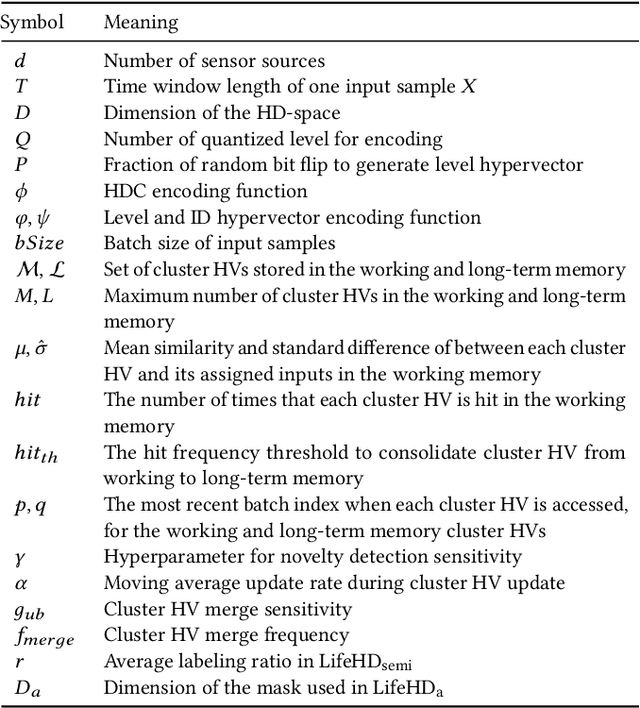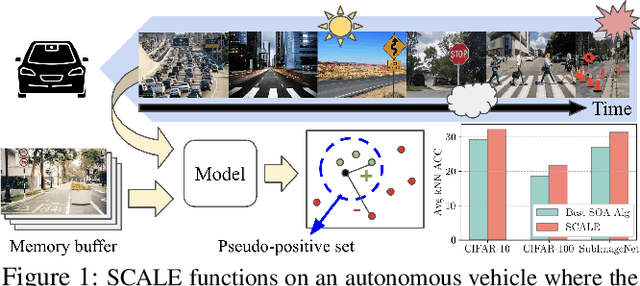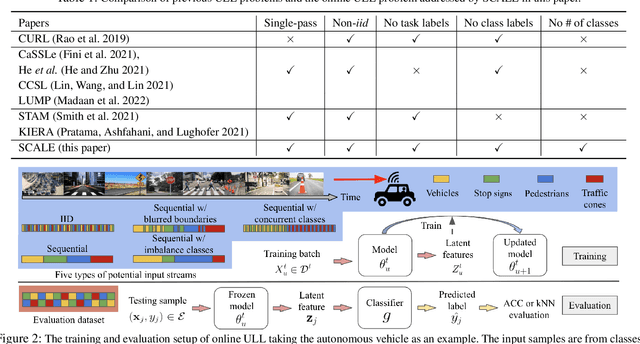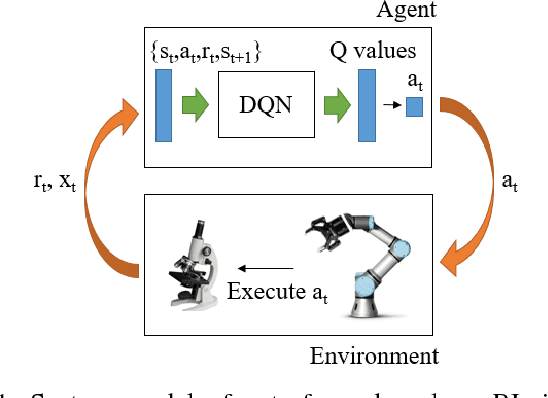Xiaofan Yu
Client Selection in Federated Learning with Data Heterogeneity and Network Latencies
Apr 02, 2025



Abstract:Federated learning (FL) is a distributed machine learning paradigm where multiple clients conduct local training based on their private data, then the updated models are sent to a central server for global aggregation. The practical convergence of FL is challenged by multiple factors, with the primary hurdle being the heterogeneity among clients. This heterogeneity manifests as data heterogeneity concerning local data distribution and latency heterogeneity during model transmission to the server. While prior research has introduced various efficient client selection methods to alleviate the negative impacts of either of these heterogeneities individually, efficient methods to handle real-world settings where both these heterogeneities exist simultaneously do not exist. In this paper, we propose two novel theoretically optimal client selection schemes that can handle both these heterogeneities. Our methods involve solving simple optimization problems every round obtained by minimizing the theoretical runtime to convergence. Empirical evaluations on 9 datasets with non-iid data distributions, 2 practical delay distributions, and non-convex neural network models demonstrate that our algorithms are at least competitive to and at most 20 times better than best existing baselines.
Orthogonal Calibration for Asynchronous Federated Learning
Feb 21, 2025Abstract:Asynchronous federated learning mitigates the inefficiency of conventional synchronous aggregation by integrating updates as they arrive and adjusting their influence based on staleness. Due to asynchrony and data heterogeneity, learning objectives at the global and local levels are inherently inconsistent -- global optimization trajectories may conflict with ongoing local updates. Existing asynchronous methods simply distribute the latest global weights to clients, which can overwrite local progress and cause model drift. In this paper, we propose OrthoFL, an orthogonal calibration framework that decouples global and local learning progress and adjusts global shifts to minimize interference before merging them into local models. In OrthoFL, clients and the server maintain separate model weights. Upon receiving an update, the server aggregates it into the global weights via a moving average. For client weights, the server computes the global weight shift accumulated during the client's delay and removes the components aligned with the direction of the received update. The resulting parameters lie in a subspace orthogonal to the client update and preserve the maximal information from the global progress. The calibrated global shift is then merged into the client weights for further training. Extensive experiments show that OrthoFL improves accuracy by 9.6% and achieves a 12$\times$ speedup compared to synchronous methods. Moreover, it consistently outperforms state-of-the-art asynchronous baselines under various delay patterns and heterogeneity scenarios.
SensorChat: Answering Qualitative and Quantitative Questions during Long-Term Multimodal Sensor Interactions
Feb 05, 2025Abstract:Natural language interaction with sensing systems is crucial for enabling all users to comprehend sensor data and its impact on their everyday lives. However, existing systems, which typically operate in a Question Answering (QA) manner, are significantly limited in terms of the duration and complexity of sensor data they can handle. In this work, we introduce SensorChat, the first end-to-end QA system designed for long-term sensor monitoring with multimodal and high-dimensional data including time series. SensorChat effectively answers both qualitative (requiring high-level reasoning) and quantitative (requiring accurate responses derived from sensor data) questions in real-world scenarios. To achieve this, SensorChat uses an innovative three-stage pipeline that includes question decomposition, sensor data query, and answer assembly. The first and third stages leverage Large Language Models (LLMs) for intuitive human interactions and to guide the sensor data query process. Unlike existing multimodal LLMs, SensorChat incorporates an explicit query stage to precisely extract factual information from long-duration sensor data. We implement SensorChat and demonstrate its capability for real-time interactions on a cloud server while also being able to run entirely on edge platforms after quantization. Comprehensive QA evaluations show that SensorChat achieves up to 26% higher answer accuracy than state-of-the-art systems on quantitative questions. Additionally, a user study with eight volunteers highlights SensorChat's effectiveness in handling qualitative and open-ended questions.
SensorQA: A Question Answering Benchmark for Daily-Life Monitoring
Jan 10, 2025Abstract:With the rapid growth in sensor data, effectively interpreting and interfacing with these data in a human-understandable way has become crucial. While existing research primarily focuses on learning classification models, fewer studies have explored how end users can actively extract useful insights from sensor data, often hindered by the lack of a proper dataset. To address this gap, we introduce SensorQA, the first human-created question-answering (QA) dataset for long-term time-series sensor data for daily life monitoring. SensorQA is created by human workers and includes 5.6K diverse and practical queries that reflect genuine human interests, paired with accurate answers derived from sensor data. We further establish benchmarks for state-of-the-art AI models on this dataset and evaluate their performance on typical edge devices. Our results reveal a gap between current models and optimal QA performance and efficiency, highlighting the need for new contributions. The dataset and code are available at: \url{https://github.com/benjamin-reichman/SensorQA}.
Lifelong Intelligence Beyond the Edge using Hyperdimensional Computing
Mar 07, 2024



Abstract:On-device learning has emerged as a prevailing trend that avoids the slow response time and costly communication of cloud-based learning. The ability to learn continuously and indefinitely in a changing environment, and with resource constraints, is critical for real sensor deployments. However, existing designs are inadequate for practical scenarios with (i) streaming data input, (ii) lack of supervision and (iii) limited on-board resources. In this paper, we design and deploy the first on-device lifelong learning system called LifeHD for general IoT applications with limited supervision. LifeHD is designed based on a novel neurally-inspired and lightweight learning paradigm called Hyperdimensional Computing (HDC). We utilize a two-tier associative memory organization to intelligently store and manage high-dimensional, low-precision vectors, which represent the historical patterns as cluster centroids. We additionally propose two variants of LifeHD to cope with scarce labeled inputs and power constraints. We implement LifeHD on off-the-shelf edge platforms and perform extensive evaluations across three scenarios. Our measurements show that LifeHD improves the unsupervised clustering accuracy by up to 74.8% compared to the state-of-the-art NN-based unsupervised lifelong learning baselines with as much as 34.3x better energy efficiency. Our code is available at https://github.com/Orienfish/LifeHD.
Async-HFL: Efficient and Robust Asynchronous Federated Learning in Hierarchical IoT Networks
Jan 17, 2023



Abstract:Federated Learning (FL) has gained increasing interest in recent years as a distributed on-device learning paradigm. However, multiple challenges remain to be addressed for deploying FL in real-world Internet-of-Things (IoT) networks with hierarchies. Although existing works have proposed various approaches to account data heterogeneity, system heterogeneity, unexpected stragglers and scalibility, none of them provides a systematic solution to address all of the challenges in a hierarchical and unreliable IoT network. In this paper, we propose an asynchronous and hierarchical framework (Async-HFL) for performing FL in a common three-tier IoT network architecture. In response to the largely varied delays, Async-HFL employs asynchronous aggregations at both the gateway and the cloud levels thus avoids long waiting time. To fully unleash the potential of Async-HFL in converging speed under system heterogeneities and stragglers, we design device selection at the gateway level and device-gateway association at the cloud level. Device selection chooses edge devices to trigger local training in real-time while device-gateway association determines the network topology periodically after several cloud epochs, both satisfying bandwidth limitation. We evaluate Async-HFL's convergence speedup using large-scale simulations based on ns-3 and a network topology from NYCMesh. Our results show that Async-HFL converges 1.08-1.31x faster in wall-clock time and saves up to 21.6% total communication cost compared to state-of-the-art asynchronous FL algorithms (with client selection). We further validate Async-HFL on a physical deployment and observe robust convergence under unexpected stragglers.
SCALE: Online Self-Supervised Lifelong Learning without Prior Knowledge
Aug 24, 2022



Abstract:Unsupervised lifelong learning refers to the ability to learn over time while memorizing previous patterns without supervision. Previous works assumed strong prior knowledge about the incoming data (e.g., knowing the class boundaries) which can be impossible to obtain in complex and unpredictable environments. In this paper, motivated by real-world scenarios, we formally define the online unsupervised lifelong learning problem with class-incremental streaming data, which is non-iid and single-pass. The problem is more challenging than existing lifelong learning problems due to the absence of labels and prior knowledge. To address the issue, we propose Self-Supervised ContrAstive Lifelong LEarning (SCALE) which extracts and memorizes knowledge on-the-fly. SCALE is designed around three major components: a pseudo-supervised contrastive loss, a self-supervised forgetting loss, and an online memory update for uniform subset selection. All three components are designed to work collaboratively to maximize learning performance. Our loss functions leverage pairwise similarity thus remove the dependency on supervision or prior knowledge. We perform comprehensive experiments of SCALE under iid and four non-iid data streams. SCALE outperforms the best state-of-the-art algorithm on all settings with improvements of up to 6.43%, 5.23% and 5.86% kNN accuracy on CIFAR-10, CIFAR-100 and SubImageNet datasets.
A Robotic Auto-Focus System based on Deep Reinforcement Learning
Sep 05, 2018



Abstract:Considering its advantages in dealing with high-dimensional visual input and learning control policies in discrete domain, Deep Q Network (DQN) could be an alternative method of traditional auto-focus means in the future. In this paper, based on Deep Reinforcement Learning, we propose an end-to-end approach that can learn auto-focus policies from visual input and finish at a clear spot automatically. We demonstrate that our method - discretizing the action space with coarse to fine steps and applying DQN is not only a solution to auto-focus but also a general approach towards vision-based control problems. Separate phases of training in virtual and real environments are applied to obtain an effective model. Virtual experiments, which are carried out after the virtual training phase, indicates that our method could achieve 100% accuracy on a certain view with different focus range. Further training on real robots could eliminate the deviation between the simulator and real scenario, leading to reliable performances in real applications.
 Add to Chrome
Add to Chrome Add to Firefox
Add to Firefox Add to Edge
Add to Edge